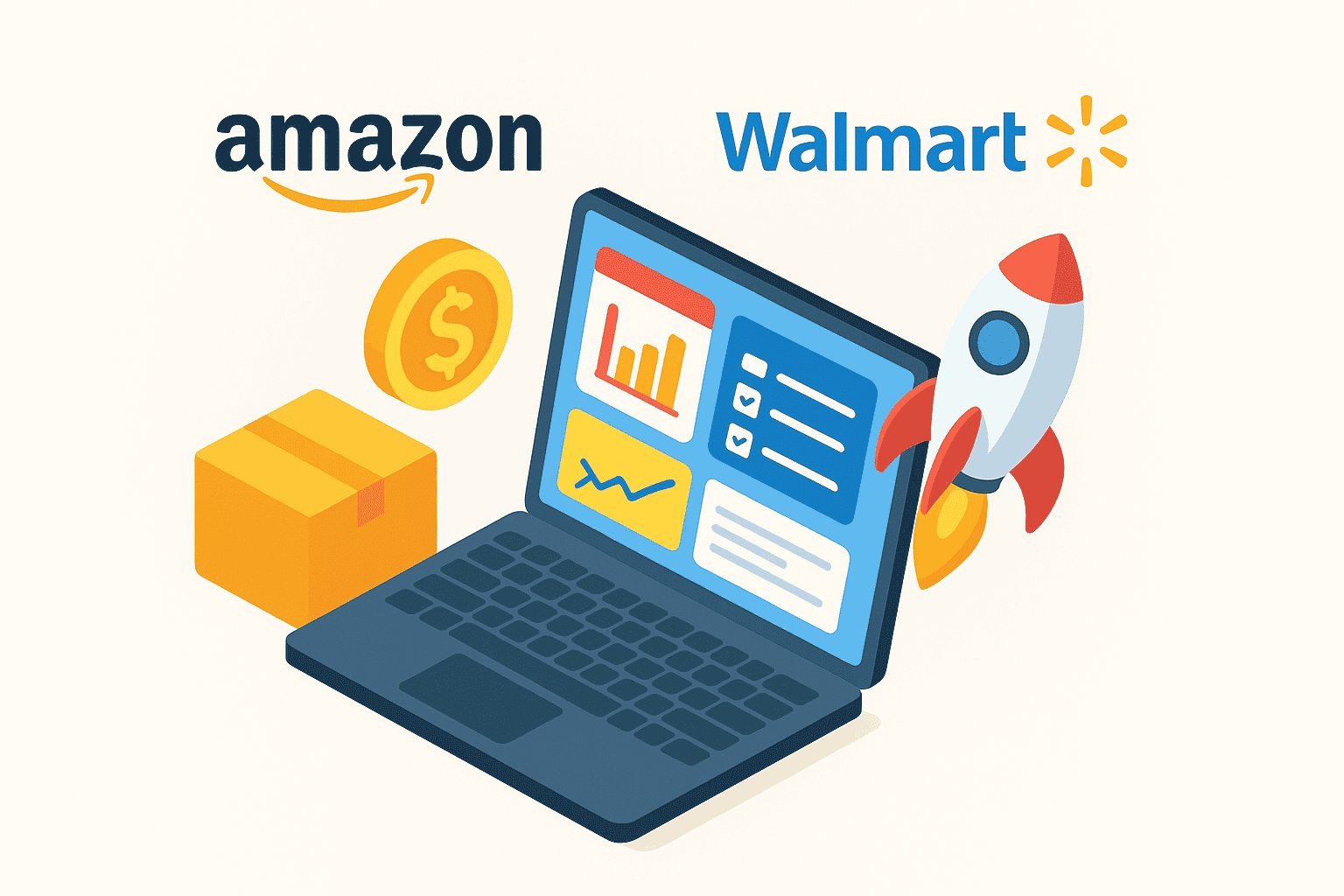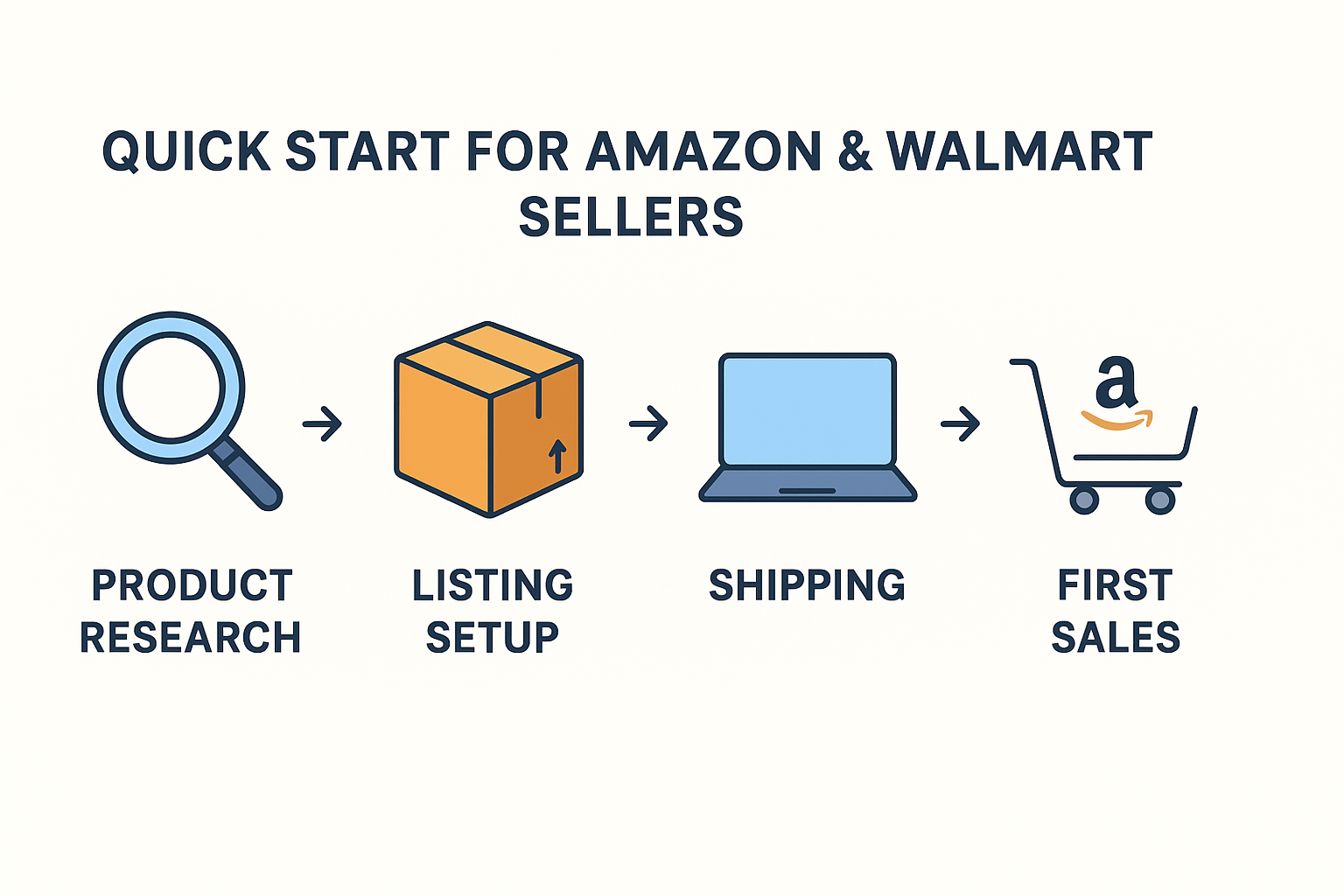Amazon & Walmart Sellers: Quick Start Guide
Start Here Guide: Amazon & Walmart
Key Takeaways
| Section | What You’ll Learn |
|---|---|
| Platforms Overview | Differences between Amazon and Walmart for new sellers |
| Account Setup | How to open a Seller Central and Walmart Seller Center account |
| Beginner Roadmap | Step-by-step process to launch your first listing |
| Seller Journey | Key milestones for first-time sellers |
| Tips & Success | Tricks, comparisons, and beginner insights |
| Wrap-Up | Quick start advice and next steps |
Introduction
If you’re fresh to the e-commerce game, this start-here guide is made for you. Selling on Amazon and Walmart may sound big, but the truth is, you can get rolling without pulling your hair out.
Think of Amazon Seller Central and Walmart Seller Center as two different highways. Both lead to shoppers, but each has its own rules, tolls, and speed limits. We’ll break things down in plain English, so you don’t get lost in the weeds.
1. Understanding the Platforms
Selling on Amazon and Walmart is not a one-size-fits-all deal. Each marketplace has its own perks, quirks, and audience.
Amazon vs Walmart Marketplace: Which is better for new sellers
For beginners, Amazon is like Times Square—crowded but full of buyers. Walmart, on the other hand, feels like a growing town square—less crowded but with room to shine.
Amazon vs Walmart seller account beginner comparison
-
Amazon Seller Central has two main plans: Individual (pay-per-item fees) and Professional (monthly fee).
-
Walmart Seller Center doesn’t charge monthly fees but takes a referral cut.
Walmart vs Amazon marketplace selling explained for new sellers
Think of Amazon as high-traffic, high-competition, while Walmart is leaner with fewer sellers but slower growth.
Amazon vs Walmart seller platform explained for beginners
Both platforms matter. Many smart sellers start with Amazon for reach, then branch into Walmart for diversity.
Table: Platform Comparison
| Feature | Amazon Seller Central | Walmart Seller Center |
|---|---|---|
| Fees | $39.99/month (Pro) + referral fees | No monthly fee, referral fees only |
| Reach | 300M+ active buyers | 150M+ visitors monthly |
| Competition | Very high | Lower than Amazon |
| Fulfillment | FBA (Fulfillment by Amazon) | WFS (Walmart Fulfillment Services) |
Bullet Points: Quick Platform Insights
-
Amazon = bigger reach but pricier to maintain.
-
Walmart = free entry but stricter onboarding.
-
Amazon FBA can speed up shipping, but fees add up.
-
Walmart WFS is newer but growing fast.
-
Many sellers use both for balance.

2. Getting Started (Account Creation & Setup)
Getting started on Amazon and Walmart isn’t rocket science, but you’ve got to play by their rules. Opening accounts in Amazon Seller Central and Walmart Seller Center is your first big step. Think of this part as getting your driver’s license before hitting the e-commerce highway.
How to create a seller account on Amazon and Walmart
On Amazon, you’ll sign up through Amazon Seller Central. You’ll need:
-
A valid business name
-
Tax ID (EIN or SSN)
-
Bank account and credit card
-
Government-issued ID
For Walmart Seller Center, you’ll apply with:
-
U.S. business tax ID (EIN)
-
W-9 or W-8 form
-
U.S.-based bank account
-
Marketplace performance history (if you’ve sold elsewhere)
Amazon and Walmart Seller Registration Guide step by step
Amazon Registration Steps
-
Go to Amazon Seller Central.
-
Choose “Individual” or “Professional.”
-
Add business info, ID, and tax details.
-
Verify via two-step authentication.
Walmart Registration Steps
-
Visit the Walmart Marketplace Application.
-
Submit business info and EIN.
-
Upload tax and banking details.
-
Wait for approval (can take 2–3 weeks).
Amazon and Walmart seller account explained for beginners
Amazon Seller Central is where you list products, track sales, and use FBA if you want shipping handled.
Walmart Seller Center is similar, but with tighter onboarding and fewer automation tools than Amazon.
Amazon and Walmart marketplace setup for new sellers
Once approved, you’ll:
-
Create your product listings (title, description, price).
-
Set up shipping methods or enroll in FBA/WFS.
-
Upload tax info and payment setup.
Table: Account Setup Comparison
| Step | Amazon Seller Central | Walmart Seller Center |
|---|---|---|
| Registration | Open to most sellers | Invite-only application |
| ID Needed | Gov. ID, Tax ID, Bank | EIN, Tax forms, Bank |
| Fees | $0 (Individual) or $39.99/mo (Pro) | No monthly fee |
| Approval Time | Instant–48 hrs | 2–3 weeks |
| Fulfillment | FBA optional | WFS optional |
Bullet Points: Key Takeaways on Setup
-
Amazon is easier to join, but costs more upfront.
-
Walmart has stricter approvals, but zero monthly fees.
-
FBA (Fulfillment by Amazon) = hands-off shipping, higher fees.
-
WFS (Walmart Fulfillment Services) = fewer sellers using it, more room to stand out.
-
Always keep tax docs, banking, and ID ready before applying.
3. Beginner Roadmap (Step-by-Step Guidance)
Here’s the part you’ve been waiting for—the roadmap. This is like GPS for your Amazon Seller Central and Walmart Seller Center journey. You’ll see the turns, the pit stops, and where to hit the gas.
How to start selling on Amazon and Walmart for beginners
Kickoff is simple. You open your account, pick a product, and make a listing. On Amazon, you’ll use the Add a Product tool. On Walmart, you’ll upload through the Seller Center dashboard.
Step-by-step process to start selling on Amazon and Walmart
Amazon Process
-
Register on Seller Central.
-
Add products with titles, bullets, and keywords.
-
Choose shipping: FBA or self-ship.
-
Set price and publish listing.
Walmart Process
-
Apply and get approval.
-
Add your product catalog.
-
Choose WFS or your own shipping.
-
Set inventory and go live.
Start selling on the Amazon and Walmart marketplaces step by step
Think small first. Maybe test with one or two products. Learn how fees, payouts, and reviews work. Once you’re comfy, expand.

Beginner tutorial to start selling on Amazon and Walmart
If you’re a total newbie, focus on:
-
Picking low-competition products
-
Writing clear, short titles
-
Adding at least 3–5 product images
-
Offering competitive pricing
How new sellers can start selling on Amazon and Walmart
For rookies, avoid selling restricted products like supplements or electronics at first. Stick to simple categories such as home goods, kitchen items, or toys.
Table: Step-by-Step Roadmap
| Step | Amazon Seller Central | Walmart Seller Center |
|---|---|---|
| Product Research | Use tools like Helium 10 or Jungle Scout | Use Walmart Marketplace Research Tools |
| Listing Creation | Title, bullets, description, keywords | Title, images, attributes |
| Fulfillment | FBA or self-ship | WFS or self-ship |
| Pricing | Competitive, dynamic repricing tools | Manual or software-based |
| Launch | Ads + reviews | Price cuts + promotions |
Bullet Points: Key Beginner Tips
-
Start small. Don’t list 50 products at once.
-
Pick products under $50 for easier sales.
-
Use FBA or WFS early to win fast shipping badges.
-
Don’t ignore reviews—customers trust them.
-
Track fees carefully; profit margins can shrink fast.
4. The Seller Journey (Learning Path)
Starting on Amazon or Walmart is not just about signing up. It’s about walking a path—like climbing stairs one by one. This journey teaches you the ropes, helps you dodge rookie mistakes, and sets you up for bigger wins down the road.
Beginner’s guide to Amazon and Walmart marketplace
The Amazon marketplace is older and packed with sellers. The Walmart marketplace is newer but growing quickly. For beginners, it’s like choosing between a crowded concert and a smaller local show. Both have fans, but the vibe is different.
Amazon and Walmart seller guide for first timers
First-timers should focus on learning how to:
-
Manage inventory in Seller Central and Walmart Seller Center
-
Handle returns smoothly
-
Track payouts and fees so you don’t lose cash unexpectedly
Amazon and Walmart E-Commerce Getting Started Guide
Think of this as your “e-commerce 101.” You learn how to:
-
Post listings
-
Ship orders
-
Collect reviews
-
Use ads inside the Amazon Advertising Console and Walmart Connect
Guide to Amazon and Walmart e-commerce for first-timers
At this stage, keep your eyes on:
-
Cash flow (don’t spend all profits too fast)
-
Customer feedback (gold for growth)
-
Fulfillment choices (FBA vs. WFS)
Amazon and Walmart seller journey start here guide
Your seller journey usually looks like this:
-
Start small (maybe 1–3 products).
-
Get first sales, learn what works.
-
Scale listings, improve content.
-
Expand into ads and promotions.
-
Branch into both Amazon and Walmart for stability.

Table: Seller Journey Phases
| Phase | Amazon Seller Central | Walmart Seller Center |
|---|---|---|
| Phase 1: Setup | Open account, list products | Apply, get approved, upload catalog |
| Phase 2: First Sales | Leverage FBA + reviews | Use low pricing + fast shipping |
| Phase 3: Growth | Sponsored ads + brand registry | Join WFS, run promotions |
| Phase 4: Scaling | Add variations, expand categories | Optimize listings, expand catalog |
| Phase 5: Maturity | Automate, outsource, multi-channel tools | Balance stock between Amazon & Walmart |
Bullet Points: Quick Seller Journey Tips
-
Don’t rush—learn each phase before scaling.
-
Treat Amazon like a traffic magnet and Walmart like a growth booster.
-
Use tools to automate repricing and stock management.
-
Keep customer service sharp—bad reviews can sink new sellers.
-
Track every fee; small leaks can drown profit boats.
5. Tips, Comparisons & Success Path
Now that you know the basics, let’s dig into tips and success hacks. Think of this as cheat codes for your journey on Amazon Seller Central and Walmart Seller Center. These insights can save you time, money, and frustration.
Amazon and Walmart: A Beginner’s guide to e-commerce success
To win early, you need:
-
Solid product research
-
Competitive pricing
-
Smart shipping (use FBA or WFS)
-
Strong reviews to build trust
Beginner roadmap for Amazon and Walmart selling
Most beginners succeed when they:
-
Start with small batches of inventory.
-
Learn the dashboards—Amazon Seller Central and Walmart Seller Center.
-
Use built-in ad tools.
-
Reinvest profits into scaling.
Amazon and Walmart marketplace tips for first-time sellers
Hot tips for newbies:
-
Keep titles under 200 characters.
-
Use lifestyle images, not just product-only shots.
-
Offer free shipping when you can—it helps conversion.
start selling on amazon and walmart marketplaces explained
Selling means more than posting a product. On Amazon, your item is ranked by sales history, keywords, and reviews. On Walmart, it’s about price competitiveness and shipping speed.
Start here, a guide for Amazon and Walmart seller beginners
If you’re brand new, bookmark your dashboards, check them daily, and treat your store like a real shop. Consistency is what separates pros from dabblers.
Table: Success Tips Comparison
| Success Factor | Amazon Seller Central | Walmart Seller Center |
|---|---|---|
| Traffic | Huge, global | Growing, U.S.-focused |
| Key to Success | Reviews + Ads | Pricing + Shipping |
| Fulfillment | FBA dominates | WFS gaining traction |
| Product Focus | Wide range, all niches | Household, essentials, mid-tier |
| Growth Hack | Sponsored Products ads | Rollback deals + promos |
Bullet Points: Practical Success Tips
-
Nail product photos—shoppers buy with their eyes.
-
Use keywords, but keep listings natural.
-
Stay flexible with pricing; markets change fast.
-
Invest in customer support early—it pays off.
-
Don’t put all eggs in one basket. Balance between Amazon and Walmart.
6. Quick Start Wrap-Up
You’ve seen the map. Now let’s tie it all up into a quick-start kit. Selling on Amazon Seller Central and Walmart Seller Center is doable if you follow the right steps and stay sharp.
How to become an Amazon and Walmart marketplace seller
To officially become a seller, you need:
-
An approved Amazon Seller Central account.
-
A verified Walmart Seller Center account.
-
At least one product that meets both platforms’ rules.
Once live, you can sell on one or both, depending on your goals.
Amazon and Walmart seller quick start: beginners’ guide
Think of this as your “one-page plan”:
-
Pick 1–2 products.
-
Open accounts on Amazon and Walmart.
-
List your products with solid titles, images, and prices.
-
Choose FBA or WFS for easier shipping.
-
Monitor sales, tweak listings, and reinvest profits.
Table: Quick Start Checklist
| Step | What to Do | Tool/Platform |
|---|---|---|
| 1 | Research products | Helium 10, Walmart Research Tool |
| 2 | Create accounts | Seller Central, Seller Center |
| 3 | List products | Product detail pages |
| 4 | Choose fulfillment | FBA / WFS |
| 5 | Launch | Ads + promotions |
Bullet Points: Quick Wins
-
Start with small, low-risk products.
-
Lean on FBA or WFS to simplify.
-
Price competitively but protect margins.
-
Keep an eye on reviews—they’re your lifeline.
-
Treat this like a business, not a side hobby.
Conclusion
Selling on Amazon and Walmart is one of the smartest ways to break into e-commerce today. You’ve learned how to compare the platforms, set up your accounts, follow a beginner roadmap, and walk the seller journey step by step.
Both Amazon Seller Central and Walmart Seller Center give you tools to grow, but the real key is consistency. Stay patient, adapt to changes, and never stop learning.
Call to Action: Amazon & Walmart Selling
You’re ready.
-
Go open your Amazon Seller Central or Walmart Seller Center account today.
-
Start small, test the waters, and scale as you grow.
-
Bookmark this guide—it’s your north star when you feel lost.
👉 The sooner you begin, the sooner you’ll see results. Jump in now and make your first sale your launchpad.